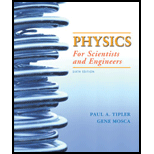
Concept explainers
The electric field at point1 and point 2.
The electric field at point1 is
The electric field at point2 is
Given:
A sphere of radius R and surface charge density
A cavity inside the sphere of radius
Formula Used:
Gauss’s theorem
E is the electric field.
Q is the charge of the spere
Calculations:
The electric field by the sphere with cavity can be calculated as two uniform spheres of equal positive and negative charge densities.
Resultant electric field is
Substituting the values
Electric field due to negative charge density using gauss theorem
Relating
Substituting values
Substituting in the equations
Calculating the electric field by the charge Q in the cavity
Resultant electric field
At point 1
At point 2
Conclusion:
The electric field at point1 is
The electric field at point2 is
Answer to Problem 85P
The electric field at point1 is
The electric field at point2 is
Explanation of Solution
Given:
A sphere of radius R and surface charge density
A cavity inside the sphere of radius
Formula Used:
Gauss’s theorem
E is the electric field.
Q is the charge of the spere
Calculations:
The electric field by the sphere with cavity can be calculated as two uniform spheres of equal positive and negative charge densities.
Resultant electric field is
Substituting the values
Electric field due to negative charge density using gauss theorem
Relating
Substituting values
Substituting in the equations
Calculating the electric field by the charge Q in the cavity
Resultant electric field
At point 1
At point 2
Conclusion:
The electric field at point1 is
The electric field at point2 is
Want to see more full solutions like this?
Chapter 22 Solutions
Physics For Scientists And Engineers
- Why do electrostatic experiments work so poorly in hunid weather?arrow_forwardThe base of an electric iron is brightly polished mainly so that ........ ?arrow_forwardRubbing two different materials having a different pull on their outer electrons, will cause the electrons to transfer between these materials. TRUE or FALSE?arrow_forward
- Will be or not q=ne n=9.2e e=-1.6*x 10*-19arrow_forwardMetal sphere A of radius 12.0 cm carries 6.00 µC of charge,and metal sphere B of radius 18.0 cm carries -4.00 µC ofcharge. If the two spheres are attached by a very long conductingthread, what is the final distribution of charge on the twospheres?arrow_forwardA spherical metallic object with a concentric hole inside initiallyholds a net charge of q1 = −3.84 nC. Then a particle with a charge ofq2 = 9.41 nC is placed at the center of the hole (held by a thin perfectnon-polarizable insulating material).The valueof the net charge on the outer surface of the conductor, upon reachingelectrostatic equilibrium, is most nearlyarrow_forward
- Two identical spheres initially carrying charges of -20 mC and +50 mC make contact for only a fewseconds. When they are separated by a distance of 2.50 cm, calculate the force experienced by each sphere.Clearly state if this force is attractive or repulsive.arrow_forwardCan mobility of charge carries can be determined from hall effects. If yes. How?arrow_forwardIn a conductor, one or more electrons from each atom are free to roam throughout the volume of the conductor. Does this contradict the statement that any excess charge on a solid conductor must reside on its surface? Why or why not?arrow_forward
- If Coulomb’s law involved 1/r3 dependence (instead of 1/r2), would Gauss’s law be still true ? Answer it.arrow_forwardME: I found the promblem on the web site (book:university-physics-with-modern-physics-14th-edition, isbn 9780321973610, chapter 21, question 27.87) only the charges are different, however I got in to touble with the conclusion. within the Eq give(Part A), the denomiator it equals to zero; at least with my math. Thanks for the help -Av Given: Two 1.20m nonconducting wires meet at a right angle. One segment carries 2.00 μC of charge distributed uniformly along its length, and the other carries − 2.00 μC distributed uniformly along it, as shown in the figure Part A: Find the magnitude of the electric field these wires produce at point P, which is 60.0 cm from each wire Part B: Find the direction of the electric field these wires produce at point P, which is 60.0 cm from each wire.(Suppose that the y-axis directed vertically.) Part C: If an electron is released at P, what is the magnitude of the net force that these wires exert on it? Part D If an electron is released at P, what is…arrow_forwardScience fiction author Larry Niven hypothesized a device that could neutralize the electric charge on the electrons in a object. When this happened, the mutual repulsion between the protons would rip the object apart on an atomic level, but rather than being instantaneous, the process took several seconds to take full effect.Suppose that this device is used on a 20.0-g block of lead, which is held rigidly fixed in place. The device neutralizes the charge of 2.3% of the electrons. Before the lead block rips itself apart, it is put into contact with a 20.0-g lead bullet which is initially uncharged. The bullet immediately contributes enough electrons to the block that the charges on the block and bullet are equal, and then the force of electrostatic repulsion launches the bullet. What is the charge on the bullet just before it launches? Assume that lead has an an atomic mass of 207.2 g/mol, and there are 82 electrons in a lead atom. -9300 C 8800 C 9300 C -8800 C 5.48 x 1022 Carrow_forward
 Principles of Physics: A Calculus-Based TextPhysicsISBN:9781133104261Author:Raymond A. Serway, John W. JewettPublisher:Cengage Learning
Principles of Physics: A Calculus-Based TextPhysicsISBN:9781133104261Author:Raymond A. Serway, John W. JewettPublisher:Cengage Learning
 Glencoe Physics: Principles and Problems, Student...PhysicsISBN:9780078807213Author:Paul W. ZitzewitzPublisher:Glencoe/McGraw-Hill
Glencoe Physics: Principles and Problems, Student...PhysicsISBN:9780078807213Author:Paul W. ZitzewitzPublisher:Glencoe/McGraw-Hill


